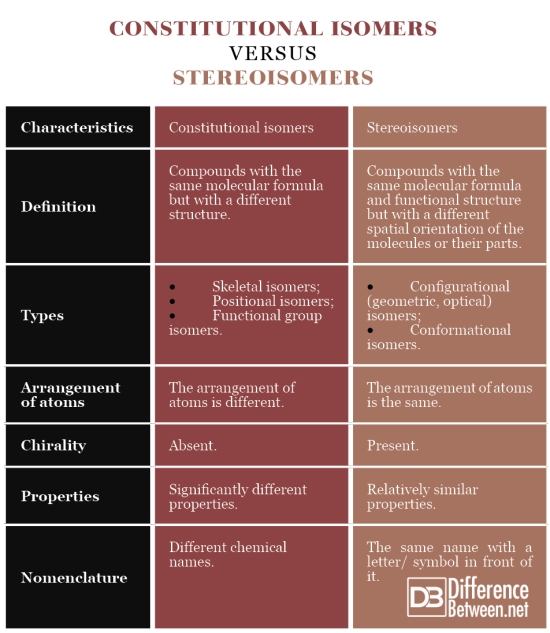Difference Between Constitutional Isomers and Stereoisomers
Isomerism is a phenomenon in organic chemistry shown by two or more compounds with the same qualitative and quantitative composition, but with different physical, chemical, and/or biological properties. The difference in the properties is due to a different structure or spatial orientation of the organic molecules.
The two main types are constitutional isomerism and stereoisomerism.
What is Constitutional Isomers?
Constitutional (structural) isomers are compounds with the same molecular formula but with a different structure.
The constitutional isomers are three types:
- Skeletal (chain) isomers;
- Positional isomers;
- Functional group isomers.
The skeletal isomers have a uniform quantitative, qualitative, and functional composition, but a structurally different chain of molecules. The chains may be straight or differently branched. Typically skeletal isomers have different physical properties.
The positional isomers differ in the location of a functional group, substituent, or complex bonds in the chain. They differ primarily in the physical properties and, in some cases, in their biochemical ones. For example, naturally occurring amino acids are predominantly alpha-isomers.
Metamerism is a form of positional isomerism in which a functional group is included in the hydrocarbon itself, thereby separating it in two differently long hydrocarbon residues. Metamerism occurs in dialkylamines, ethers, etc.
The functional isomers have the same quantitative and qualitative composition but different functional groups. This leads to a difference in their chemical properties. Classic examples of functional isomers are the glucose and fructose. In the nature, the functional isomers are with a different biochemical importance.
Tautomerism is a type of structural isomerism in which, under certain conditions, a certain spatial structure translates into another, with a dynamic equilibrium between them. Tautomerism can be seen as a form of functional isomerism.
What is Stereoisomers?
Stereoisomers (spatial isomers) have the same qualitative, quantitative and functional structure but a different spatial orientation of the molecules or their parts. The reason for spatial isomerism is the different spatial symmetry of the molecules. The main elements of symmetry are center, axis, and plane.
The stereoisomers can be:
- Configurational isomers:
- Geometric;
- Optical.
- Conformational isomers.
Geometric isometry is due to differences in the spatial arrangement of the substituents relative to the symmetry plane. It consists in the possibility of placing substituent groups on the one side of a non-aromatic cycle or a double bond plane, or on different sides. The isomer with two identical substituents on one side of the plane is called cis-isomer and the other one – trans-isomer.
In optical isomerism, the molecules have no center, axis, and plane of symmetry. Isomers of this type have asymmetric molecules. Each molecule refers to its isomer as an object to its mirror image. Optical isomers have the common name enantiomers. The biological significance of the enantiomers is different. They have the same chemical properties. From their physical characteristics, only their optical activity differs. The two enantiomers rotate differently the polarized light. On the nomenclature, they are marked with Latin S – left and R – right (the old labels are L and D). The natural isomers are predominantly S-isomers. An equimolar mixture of the two enantiomers is called a racemic mixture and is optically inactive.
Spatial isomerism in which isomers have the same configurations but a different spatial orientation is called conformational. The differences in the isomers do not result from breakage of bonds and displacement of the substituents and are a consequence of the rotation of different parts of the molecule around the axis of simple sigma bonds. The resulting isomers are with a different conformation and are called conformers. They generally differ only in their optical properties.
Difference Between Constitutional Isomers and Stereoisomers
-
Definition
Constitutional isomers: Constitutional (structural) isomers are compounds with the same molecular formula but with a different structure.
Stereoisomers: Stereoisomers (spatial isomers) are compounds with the same molecular formula and functional structure but with a different spatial orientation of the molecules or their parts.
-
Types
Constitutional isomers: The constitutional isomers can be skeletal, positional, and functional group isomers.
Stereoisomers: The stereoisomers can be configurational (geometric, optical) and conformational isomers.
-
Arrangement of atoms
Constitutional isomers: The arrangement of atoms of constitutional isomers is different.
Stereoisomers: The arrangement of atoms of stereoisomers is the same.
-
Chirality
Constitutional isomers: Chirality is absent in constitutional isomers.
Stereoisomers: Chirality is present in stereoisomers.
-
Properties
Constitutional isomers: Constitutional isomers have significantly different properties.
Stereoisomers: Stereoisomers have relatively similar properties.
-
Nomenclature
Constitutional isomers: Constitutional isomers often have different chemical names.
Stereoisomers: Stereoisomers often have the same name with a letter/symbol in front of the name, for identification of orientation.
Constitutional Isomers Vs Stereoisomers: Comparison Chart
Summary of Constitutional Isomers and Stereoisomers
- Constitutional (structural) isomers are compounds with the same molecular formula but with a different structure.
- Stereoisomers (spatial isomers) are compounds with the same molecular formula and functional structure but with a different spatial orientation of the molecules or their parts.
- The constitutional isomers can be skeletal, positional, and functional group isomers. The stereoisomers can be configurational (geometric, optical) and conformational isomers.
- The arrangement of atoms is different in the constitutional isomers and the same in stereoisomers.
- Chirality is absent in constitutional isomers and present in stereoisomers.
- The constitutional isomers have significantly different properties, while the stereoisomers have relatively similar properties.
- Constitutional isomers often have different chemical names. Stereoisomers often have the same name with a letter/symbol in front of the name, for identification of orientation.
- Difference Between Gallstones and Cholecystitis - September 5, 2021
- Difference Between Constipation and Cramping - August 4, 2021
- Difference Between Whole Genome Sequencing and Microarray - May 6, 2021
Search DifferenceBetween.net :
Leave a Response
References :
[0]Hoffman, R. Organic Chemistry (2nd Edition). Hoboken: John Wiley & Sons, Inc. 2004. Print.
[1]Kirkova, E. General Chemistry. Sofia: Kliment Ohridski. 2002. Print.
[2]Petrov, G. Organic Chemistry. Sofia: Kliment Ohridski. 2006. Print.
[3]Image credit: https://upload.wikimedia.org/wikipedia/commons/thumb/0/04/Isomerism.svg/640px-Isomerism.svg.png
[4]Image credit: https://upload.wikimedia.org/wikipedia/en/4/4d/Isomer_Flow_Chart.png



